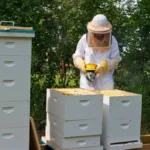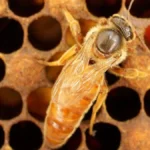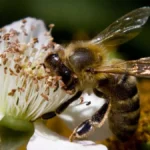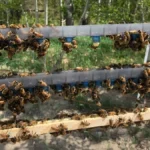In this article, we show you how to split a beehive without a queen. Splitting beehives allows us to increase our beehive numbers. This may not be the best way to split a hive, but there are times when it helps to know how to split a beehive without a queen.
How To Split A Beehive
We have covered the basics of splitting a hive here. To summarise that article, if you need to split hives, the hives must be strong enough. Normally we would prepare a few queen cells before splitting, or, order some queens in cages. This allows one to split a beehive in such a way that a queen is almost ready to take over the splits.
However, things can go wrong – your queen cells may fail, or your queens may not arrive due to a transport problem. In this case, we move to the next best option – splitting hives without adding a queen or a queen cell. However, as we will see later, this emergency method may be the best.
How To Split A Beehive Without A Queen
Splitting The Beehives
There are many complicated methods to do this. I believe in life, complexity invites failure. Hence simple methods work well.
I have used this method to make many splits over the years with a high level of success. Go to your hive, smoke it. Move the hive a foot to the left. Place an empty box a foot to the right next to your hive. Remove exactly half of the frames from the mother hive to the daughter hive.

There must be freshly laid egg combs in each hive. We don’t know which hive has a queen and which does not. Bees need fresh eggs to make a good queen cell.
If you are splitting into two 5 frame nucleus boxes, then put the lids on, load one box on your truck, and move it at least 4 miles away. If you are using brood boxes, fill the empty space in the boxes with extra combs and put the lids on, and move one hive away in the truck. More the hive that stays back to the original spot.
Inspecting The Hive
A week after you have made these splits have a look inside the hives. One hive will have queen cells. This was the one that did not get the queen. In a few days, she will hatch, go on a mating flight and return to the hive, and begin laying eggs.

You lose nearly three weeks of egg-laying in this method, but the bees will somehow bounce back.
The Best Way To Split A Hive
The above method is probably not the best way to split a hive at face value. If you perform a split where you add a queen cell or a caged queen, the rate at which your splits recover and grow is faster. However, nature is very complex and I will go into some of the advantages of letting your bees rear their own queens.
Genetic Diversity Is Key To Disease Resistance
If we imagine a beehive, the only reproductive in that hive is actually the queen. The drones are her offspring, and the workers are her offspring. If she produces a queen, it is clearly her daughter.
When we buy queens from a commercial queen rearing operation, they tend to use mother hives with a “good” queen to produce thousands or even tens of thousands of daughter queens. If you buy queens from one producer, you are buying daughters.
You now populate your apiary with queens that are sisters. If they requeen naturally, all the drones they are getting from your apiary are a very very close family. And we know what happens when a family makes babies with relatives – the babies come out a big “bug eyed” to use a bad pun.
When we lose genetic diversity in any population we lose disease resistance and vigor. We may have some traits which are good, but we lose a lot of others. Diversity is strength.
The Advantages Of Making Splits Without Adding Queens
When we make a split without adding a queen, the bees are just doing their own thing. A queen will be made, and she will go out and mate with the drones she finds, and come back and lay eggs. If we do this again and again, our bees will adapt to the area they are in.
Let us unpack this a bit. Successful hives produce more drones (assuming you don’t remove drone brood). These successful hives have a big footprint in the gene pool in the area. They are probably successful because their bees are efficient.
When a queen mates, she mates with a lot of drones. She flies really fast to tire the boys out on her mating flight and then slows down and lets the front runners in the drone comet catch her. These are the best, fastest, strongest drones. Their offspring will be the best, fastest strongest bees.
If we repeat this process over and over each year, our bees become locally adapted. There are advantages to sometimes introducing a new gene line into an apiary so that these genes can supplement locally adapted genes, and some of the new genes may also be useful. If they are not they will get weeded out quite quickly.
How Serious Is Genetic Diversity?
A Case Study In A Genetically Diverse Bee Population
I have worked with bees all over the world and thought I would share this little story to highlight the importance of genetic diversity. In the 1990’s the varroa mite was causing havoc in the USA and Europe. Bees were being decimated.
I was in South Africa at that time and keeping Apis mellifera capensis. This is a peculiar bee that has workers that can lay fertilized eggs alongside the queen. The beehives have incredible genetic diversity.
In 2006 Varroa mites arrived in my apiaries. For about two years we had a bit of damage in the hives – chalkbrood, reduced drone numbers, bees with deformed wings. Some hives died. After a few more years, something happened and now you struggle to find a varroa mite in a drone cell.
The genetic diversity in the Cape Honeybee in this area allowed them to find some useful genes that helped them overcome and live with varroa. Now we regularly see beehives that were as strong as before varroa, and this requires no management to achieve at all.
In Summary
Making splits and not adding queens purchased from low genetic diversity suppliers may cost you a few weeks egg-laying, but, it may allow you to begin to adapt your bees to your unique local conditions. Adapted bees are the best bees. Just like you will take years to learn how to keep bees in your area, bees will take years to adapt to your area.
We hope you enjoyed this article. Please share with friends – the genetic diversity lesson is an important one. And for some reason it is not that widely acknowledged.

Dr. Garth A. Cambray is a Canadian/South African entrepreneur and beekeeper with 28 years of experience in apiculture and specializes in adding value to honey. His Ph.D. research developed a new advanced continuous fermentation method for making mead that has resulted in a number of companies globally being able to access markets for mead. His company, Makana Meadery, exports honey mead to the USA where it is available to discerning connoisseurs. He has also developed technologies to commercially manufacture organic honey vinegar in Zambia for export globally. He holds a few patents globally in the ethanol industry and believes in technology and knowledge transfer for human development and environmental sustainability. One of his proudest achievements is the fact that the wind farm he started at one of his old apiary sites has essentially made his hometown carbon neutral.






